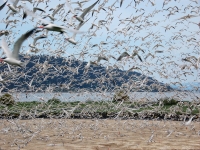forum
library
tutorial
contact

Bald Eagles Decimate Tern and Cormorant Colonies
by Vince PattonOregon Public Broadcasting, June 13, 2011
|
the film forum library tutorial contact |

|
Bald Eagles Decimate Tern and Cormorant Colonies
by Vince PattonOregon Public Broadcasting, June 13, 2011 |
 Not a single chick has survived this year at the world's largest colony of Caspian terns. Researchers call it "complete colony failure." Meanwhile, on the very same island in the mouth of the Columbia River, the world's largest double-crested cormorant colony also faces mass nest collapse.
Not a single chick has survived this year at the world's largest colony of Caspian terns. Researchers call it "complete colony failure." Meanwhile, on the very same island in the mouth of the Columbia River, the world's largest double-crested cormorant colony also faces mass nest collapse.
Don't blame humans for these unprecedented colony catastrophes. The chief culprits are bald eagles and, to a lesser degree, the weather.
Field monitors have watched eagles walk boldly through the cormorant colony during the day stealing eggs. Cormorants flee for an entire day and now the vast majority of nests are abandoned, though a number are trying to restart their nesting.
Bird Research Northwest reports that of nearly 5000 Caspian tern nests this year, only two chicks had been spotted by May 31. Within one hour, both chicks had disappeared, eaten by predatory gulls who often capitalize on the disturbances caused by eagles.
Eagles frequently cause disturbances more than outright deaths. All they have to do is fly in for an attack on an adult. That prompts the whole colony to fly off for safety, leaving their nests unprotected. Eggs then go cold or get stolen by other predators.
Gulls steal fish from terns in addition to their eggs. Courtesy Bird Research Northwest. As bald eagles have rebounded to healthy numbers they've begun to hunt, kill and eat more sea birds. Oregon Field Guide reported two years ago about how bald eagles had prevented any common murres from being born north of Newport. Now the eagles have found new prey in the terns and cormorants.
In addition to the eagles, the weather and high river runoff have done no favors to the birds. A major rainstorm on May 23 also caused flooding in the terns' prime nesting grounds.
Adult terns who would normally be tending nests are leaving. The peak of 12,000 Caspian terns counted in mid-May had dropped in half by early June.
While this may be terrible for the birds, might this be good news for the endangered salmon they eat? Not necessarily. Biologists have been watching what they eat and this year salmon account for 75% of their diet, compared to 60% in past years. Perhaps high rivers have changed the estuary so much that ocean fish aren't coming in leaving salmon as the primary food source. If the nests truly have failed and the birds abandon them early, salmon might catch a break as the birds leave the area.
Bird Research Northwest's weekly updates on what their field monitors are seeing. Also see Video of Eagle stealing fish from Caspian Tern
Oregon Field Guide reports on eagle attacks on murres:
Oregon Field Guide reports on terns & cormorants in 2008:
Related Pages:
Survival of Snake River Salmon & Steelhead Data compiled 2004 by bluefish.org
Steelhead-Munching Mid-Columbia Terns Fingered in Report by Bill Rudolph, NW Fishletter, 5/12/11
Vince Patton
Bald Eagles Decimate Tern and Cormorant Colonies
Oregon Public Broadcasting, June 13, 2011
learn more on topics covered in the film
see the video
read the script
learn the songs
discussion forum
